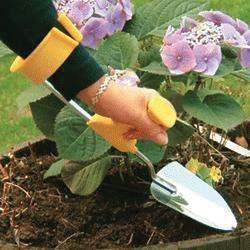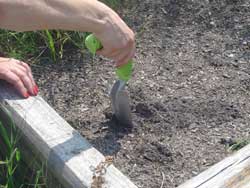
Garden Ergonomics
Download a PDF of this fact sheet.
What is ergonomics?

Ergonomics looks at how to do a task in the safest and most efficient way. It looks at designing tools, machinery, and anything else involved in a task to fit how a person naturally moves their body. A person's movement is looked at so using tools and completing the task have as little physical impact on the body as possible. In general, ergonomics looks at matching the physical demands of a task with the capabilities of the person doing the task. This match is important because it can lower the risk of injury for the person doing the task; improves the person's work efficiency; and increases the person's satisfaction in doing the task.
More specifically for gardening, ergonomics focuses on choosing the right tool for a particular chore and choosing the tool that best fits the gardener. You know you have picked the right tool for the job when you do not have to adapt the tool. The tool fits you well (matches your height or fits your grip) when it feels comfortable and natural when using.
In this packet, ergonomics refers to doing gardening chores in the safest way possible while lessening the physical impact to your back, knees, wrists, arms and hands.
Ergonomic considerations
Keeping good posture, i.e. keeping your back straight, is a quick and easy way to lessen stress on your tendons and joints. Injuries can be prevented by reducing this stress. Keeping good posture also decreases muscle pain and fatigue.
- Keeping your back straight is easier if you use long-handled tools and handle extenders, such as hoes, rakes, and brooms. Keeping your back straight helps the nerves in your back from stretching and stressing your spine.
- Long-handled tools should be as tall as, or taller, than you. This lets you stand straight. Grasp the handle with both hands, thumbs up, and bend with your knees to move the tool sideways.
 Bend your knees, not your back. It also helps to carry boxes and bags from the bottom, not by their tops or handles. Lift the object by holding its bottom and straighten your knees while in the bent position. This keeps your back straight when you stand up.
Bend your knees, not your back. It also helps to carry boxes and bags from the bottom, not by their tops or handles. Lift the object by holding its bottom and straighten your knees while in the bent position. This keeps your back straight when you stand up.- When working close to the ground, as when you are weeding, kneel with one knee, not both. Kneeling on both knees can cause you to round your back. You can keep your back straight by kneeling only on one knee.
- Whether you garden while sitting or kneeling, bend forward from your hips. This helps keep your back straight and your back from rounding.
- Tools with built-up cushioned grips, or grip handles that clamp onto a standard tool, make handles larger and easier to hold. These handles lessen the impact that work has on your hands and wrists. This in turn makes you feel less strain, stress and pain.
- Cushioned grips and grip handles prevent wrists from bending forward or being pushed toward one side. This can cause loss of grip strength and can hurt your joints. Repetitive motion injuries, like carpal tunnel syndrome, could develop.
- You can adapt long handled tools to work for you in a sitting position. Place a triangular block of 4" x 4" x 1" lumber on the ground with the tool propped over it. The wood supports the weight of the tool so your energy is used to move the tool. Your energy is not wasted in holding, directing, or lifting the tool. Since the wood supports the weight of the tool, there is less stress on your wrists, upper arms, and shoulders.
Ergonomic tools are designed to lessen the physical impacts of gardening on your body. Ergonomic tools offer many benefits to gardeners.
- Stay healthy. Your chances of injury are reduced because ergonomic tools are designed to fit your natural body positions. The tools force you to work in a good posture without extreme leaning or twisting. Since ergonomic tools do not require you to use a lot of force, you reduce the chance of back and shoulder injuries. You are also less likely to develop repetitive stress injuries, like carpal tunnel syndrome.
- Do more in less time. Ergonomic tools are designed to be efficient. You can complete more in the same amount of time as it takes to do chores with non-ergonomic tools. Since ergonomic tools force you to keep good posture, you will not tire out as quickly. For example, you can dig more and trim higher.
- Increase your capabilities. The basics of ergonomics is to keep you using the tool in a natural position. This increases efficiency because your power in doing the task is transferred through forward motion. You do not lose power to bending and twisting. For example, grip strength is at its highest when the wrist is straight. Testing has shown that people lose up to 25% of their grip strength when their wrist is bent. It is also dangerous to bend your wrists while gardening. This irritates the tendons in your wrists and hands.
What to look for in ergonomic tools
There are two main positions gardeners are in when gardening. Gardeners are either standing or kneeling.
- Kneeling. The handle's shape and gripping surface are the two most important parts of ergonomic tools while kneeling. Look for a handle that can support the tool and be 'user friendly' to your hands, wrists and forearms. Make sure the handle can support a two-handed grip as some jobs require the use of both hands. The handle's grip should be soft but firm, and thick enough to be comfortable. Also, look for non-slip grips and weatherproof material.
- Buy hand tools that fit your hand. There are many different designs. Try them all out to decide which fits you the best.
- Hand tools with looped handles, swivel grips, and ratcheting gears are easier to squeeze and take less effort to use.
- Ergonomic hand tools are designed with handles that keep your wrist straight. This reduces stress on your wrist. Some ergonomically designed hand tools also have forearm braces that make your arm do the work. This also reduces stress on your wrist. This support helps prevent muscle and joint fatigue for the gardener. The gardener will be able to garden for longer periods of time and more comfortably.
- Standing. The tool's handle and foot surfaces are the important parts of ergonomic tools while standing. Ultimately, you are looking for a handle that lets your hands, arms, and legs work together. This gives maximum leverage with the least amount of effort. You are also looking for a handle grip that is soft but firm, and thick enough to be comfortable. Also, look for non-slip grips and weatherproof materials.
For tools that you use your feet to do the work, like a shovel, make sure the tool has a 'comfort zone' for foot safety. This zone should position your foot directly over the tool head.
General rules of thumb when selecting ergonomic tools

- Find the right grip. Make a circle with your index finger and thumb. That is the size that the grip of your tools should be. Larger grips are easier to hold.
- Use tools with long handles. This cuts down on bending, reducing the risk of back injuries.
- Choose the tool with the lightest weight possible but that is sturdy enough to get the job done.
- Keep your back and joints straight. This lessens the risk of repetitive stress injuries.
- Use tools with grips that are soft and non-slip.
- Wear ergonomic work gloves. Gloves offer support and warmth for sore or arthritic hands. You will have a better grip when wearing comfortable, properly sized gloves with textured grips. Wearing gloves also helps prevent blisters.
Resources
Find more information on gardening posture and picking the tool that is right for you in these resources:
- To learn about ergonomics and making gardening more accessible for people with special needs, visit http://gardeningsolutions.ifas.ufl.edu. Type 'ergonomics' to search the site.
- Making Gardening more Accessible, a book by Charlie Nardozzi
If you would like to talk to someone about accessible gardening, or would like a garden assessment done, call Green Thumbs, Healthy Joints at 800-841-8436.

